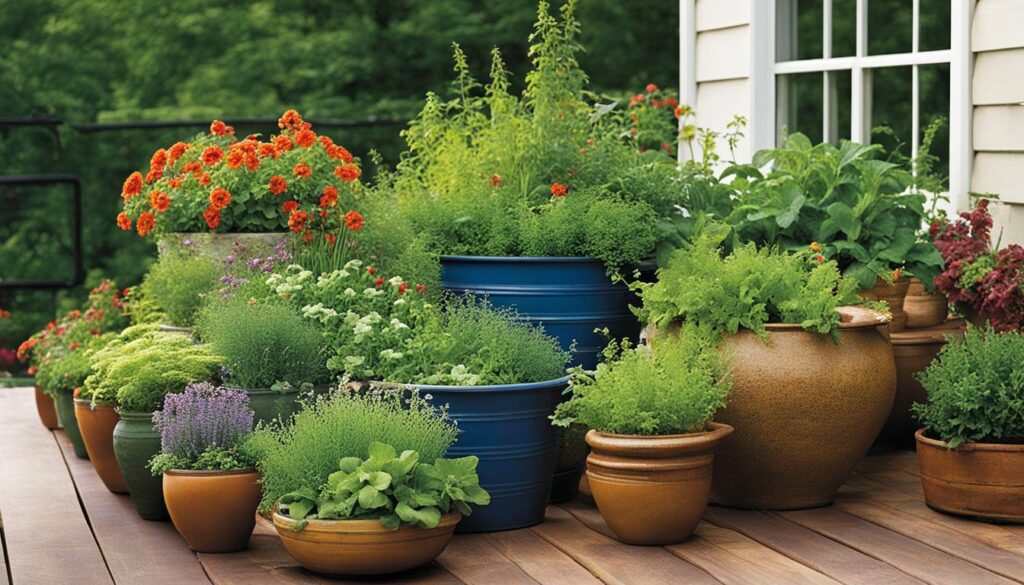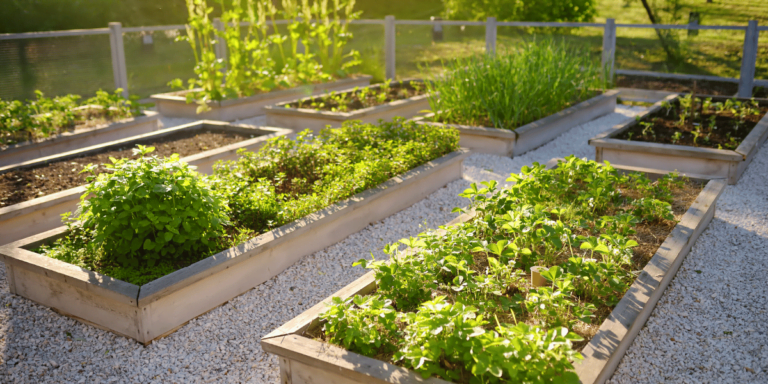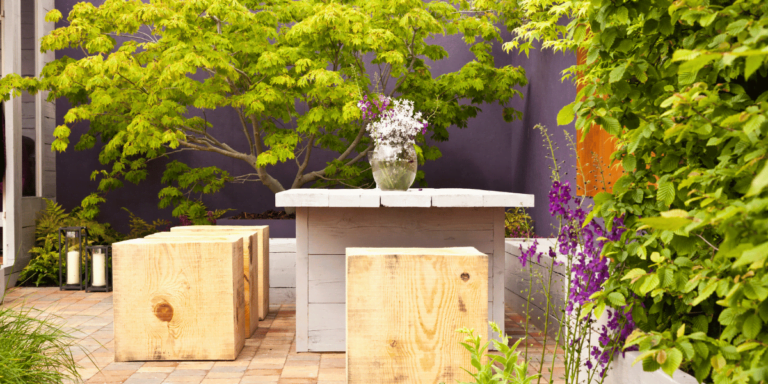Welcome to the world of sustainable urban gardening and eco-friendly landscape design. Rooftop gardens provide a unique opportunity to create lush green oases in the heart of urban jungles. With the right layout and design, you can transform your rooftop into a beautiful and eco-friendly retreat that promotes environmental sustainability.
Rooftop gardening allows you to utilize otherwise unused space and bring nature back into the urban landscape. By incorporating sustainable gardening practices and eco-friendly design techniques, you can create a space that not only enhances the aesthetics of your building but also contributes to a greener and healthier environment.
In this article, we will explore various strategies and tips for maximizing your rooftop garden layout. From utilizing vertical space and container gardening to maximizing sunlight and implementing water conservation techniques, we will provide you with valuable insights to design and maintain a thriving rooftop garden. We will also delve into the creation of wildlife habitats, embracing biophilic design principles, and incorporating contemporary garden artistry to elevate your rooftop garden to the next level.
Key Takeaways:
- By incorporating sustainable urban gardening practices, you can create a beautiful and eco-friendly rooftop garden.
- Utilizing vertical space and container gardening techniques can maximize the amount of greenery in your rooftop garden.
- Consider the amount of sunlight and wind exposure in your rooftop garden and take appropriate measures to optimize these factors.
- Implement water conservation techniques, such as efficient irrigation systems and rainwater harvesting, to promote sustainability in your rooftop garden.
- Create wildlife habitats and green roof ecosystems to contribute to biodiversity conservation and enhance the ecological value of your rooftop garden.
Think Vertical: Utilizing Vertical Space in Rooftop Gardens
Maximizing your rooftop garden layout requires thinking vertically to make the most efficient use of space. By utilizing the vertical dimension, you can create a flourishing oasis even in the smallest of urban settings. This section explores space-efficient vertical gardening techniques, high-tech smart gardening solutions, and urban permaculture practices that optimize the use of vertical space and promote sustainability in rooftop gardens.
Space-Efficient Vertical Gardening
Space-efficient vertical gardening involves growing trailing and vining plants that thrive in limited areas. By utilizing trellises, window boxes, hanging baskets, and shelves, you can create multiple layers of plants, maximizing the amount of greenery in your rooftop garden. This innovative technique allows you to grow a diverse range of plants in a compact space, transforming your rooftop into a lush, green paradise.
High-Tech Smart Gardening
High-tech smart gardening takes rooftop gardening to the next level by incorporating advanced technologies and automation. With the help of smart irrigation systems, weather sensors, and smartphone-controlled monitoring, you can optimize water usage, provide precise nutrients, and regulate lighting conditions. Smart gardening not only enhances plant growth but also saves time and resources, making it ideal for urban dwellers with busy lifestyles.
Urban Permaculture Practices
Urban permaculture practices are essential for creating sustainable rooftop gardens that function as self-sustaining ecosystems. By implementing permaculture principles such as companion planting, natural pest control methods, and efficient water management, you can minimize waste, conserve resources, and support biodiversity in your rooftop garden. Urban permaculture harmonizes natural processes with human interventions, creating resilient and productive rooftop ecosystems.
By combining space-efficient vertical gardening, high-tech smart gardening, and urban permaculture practices, you can transform your rooftop garden into a vibrant and sustainable oasis that maximizes the use of limited space. The next section explores another important aspect of rooftop gardening—container gardening—and how it offers flexibility and versatility in designing your rooftop garden.
Container Gardening: Flexibility and Versatility in Rooftop Gardens
Container gardening is a popular choice for rooftop gardens due to its flexibility and versatility. Whether you have a small balcony or a spacious rooftop, containers allow you to create an efficient and productive garden that suits your space and preferences. With the right container selection and gardening techniques, you can maximize the potential of your rooftop garden.
Indoor Hydroponic Systems
Indoor hydroponic systems offer a revolutionary way to grow plants without soil, making them ideal for rooftop gardens. By providing plants with water and essential nutrients directly to their roots, hydroponic systems promote faster growth and higher yields. Additionally, indoor hydroponic systems can be placed in any corner of your rooftop garden, utilizing vertical space and increasing the overall productivity of your garden.
Organic Composting Methods
Organic composting is an eco-friendly and sustainable method of enriching the soil in your containers. By composting kitchen scraps, yard waste, and other organic materials, you can create nutrient-rich compost that nourishes your plants and promotes healthy growth. Incorporating organic composting methods in your rooftop garden allows you to reduce waste, minimize the use of synthetic fertilizers, and create a self-sustaining ecosystem.
Rooftop Garden Containers
The choice of containers plays a crucial role in rooftop gardening. Opt for lightweight, durable, and weather-resistant containers that can withstand the harsh elements of rooftop environments. Consider using containers of different sizes and shapes to add visual interest and create a layered effect in your garden. Additionally, choose containers with proper drainage to prevent waterlogging and maintain healthy roots.
Integrating indoor hydroponic systems, utilizing organic composting methods, and selecting the right containers are key steps in creating a thriving rooftop garden. The flexibility and versatility of container gardening allow you to experiment with various plant varieties, rearrange your garden layout, and adapt to changing seasons. So start planting in containers and make the most of your rooftop space!
Maximizing Sunlight and Wind Protection in Rooftop Gardens
When planning your rooftop garden layout, two factors play a crucial role in ensuring the success and health of your plants: sunlight and wind exposure. It is essential to optimize these conditions to create an optimal environment for your rooftop garden.
Maximizing Sunlight
Sunlight is a vital resource for plant growth and photosynthesis, so understanding the sunlight patterns on your rooftop is essential. Different plants have varying sunlight requirements, so it is crucial to choose plants that thrive in the available sunlight. Evaluate the sunlight exposure on your rooftop garden and select plant species accordingly.
Here are some tips to maximize sunlight in your rooftop garden:
- Position sun-loving plants in areas with direct sunlight for the majority of the day.
- Place shade-tolerant plants in areas with partial sunlight or shade.
- Consider using reflective surfaces, such as light-colored mulch or reflective materials, to optimize sunlight reflection.
Wind Protection
Strong winds can damage plants and hinder their growth in rooftop gardens. To protect your plants from the harmful effects of wind, consider installing windbreaks or wind protection measures. These structures act as barriers and shield your plants from strong gusts.
Here are some effective wind protection strategies for your rooftop garden:
- Install trellises or screens to create a physical barrier that breaks up wind flow.
- Use fences or walls to obstruct wind and create a sheltered microclimate.
- Choose wind-resistant plant varieties that can withstand strong gusts.
By incorporating wind protection measures, you can safeguard your plants and create a more favorable growing environment in your rooftop garden.
Remember, proper planning and consideration of sunlight and wind exposure are essential for maximizing the potential of your rooftop garden. By optimizing these conditions, you can create a thriving and lush oasis in the heart of the city.
Water Conservation and Irrigation Systems for Rooftop Gardens
Water is a critical component when it comes to rooftop gardening. To ensure the sustainability of your rooftop garden, it’s essential to implement innovative water conservation techniques. By reducing water waste and exploring alternative water sources, you can minimize the environmental impact of your garden while still enjoying lush greenery. Two effective methods of water conservation for rooftop gardens are efficient irrigation systems and rainwater harvesting.
Efficient Irrigation Systems
Installing an efficient irrigation system is key to minimizing water waste and ensuring proper watering for your rooftop garden. One popular method is drip irrigation, which delivers water directly to the base of the plants, reducing evaporation and runoff. This targeted approach ensures that plants receive adequate moisture while conserving water.
Another option is to use self-watering containers. These containers have built-in reservoirs that provide a steady supply of water to the plants’ roots, reducing the need for frequent watering. Self-watering containers are especially useful for busy individuals or those inexperienced with gardening, as they help maintain consistent moisture levels.
Rainwater Harvesting
Rainwater harvesting is an innovative technique that allows you to collect and store rainwater for use in your rooftop garden. By capturing rainwater, you can reduce your reliance on municipal water sources and conserve this precious resource. Rainwater can be collected from rooftops using gutters and downspouts, then stored in containers or rain barrels. This stored water can be used to irrigate your plants during dry periods, ensuring they receive the moisture they need.
In addition to its water conservation benefits, rainwater is also naturally free of the chemicals often found in tap water, making it a healthier choice for your plants. Implementing rainwater harvesting in your rooftop garden not only promotes sustainability but also helps create a more self-sufficient and eco-friendly garden.
| Benefits of Efficient Irrigation Systems and Rainwater Harvesting |
|---|
| 1. Minimizes water waste |
| 2. Reduces reliance on municipal water sources |
| 3. Conserves water resources |
| 4. Promotes sustainability |
| 5. Provides chemical-free water for plants |
By implementing efficient irrigation systems and rainwater harvesting, you can contribute to water conservation efforts while maintaining a thriving rooftop garden. These techniques not only minimize your environmental footprint but also help create a more self-sufficient and sustainable urban oasis.
Creating Wildlife Habitats and Green Roof Ecosystems
Rooftop gardens present a unique opportunity to not only enhance the aesthetics of urban environments but also contribute to biodiversity conservation. By incorporating native plants, water features, and shelter structures, you can create wildlife habitats and green roof ecosystems that support local flora and fauna. Additionally, these green roof ecosystems play a vital role in mitigating the urban heat island effect, improving air quality, and providing a habitat for birds, insects, and other wildlife.
To create a wildlife habitat garden in your rooftop oasis, consider the following:
- Choose native plants: Selecting native plants that are well-suited to your region’s climate and conditions will attract local wildlife and promote biodiversity. These plants provide food and shelter for birds, butterflies, bees, and other beneficial insects. Incorporate a diverse range of flowering plants, shrubs, and trees to accommodate a variety of species.
- Add water features: Installing a small pond, bird bath, or a water fountain in your rooftop garden can attract birds and other wildlife, providing them with a much-needed water source. Ensure the water is clean and regularly maintained to keep it attractive to animals.
- Create shelter structures: Incorporate birdhouses, bat boxes, and bee hotels to provide shelter for wildlife. These structures offer safe nesting spaces for birds, bats, and solitary bees, helping to support their populations.
- Minimize pesticide use: Avoid using pesticides and synthetic fertilizers in your rooftop garden as they can harm wildlife. Instead, opt for organic gardening practices and natural pest management methods.
By implementing these wildlife-friendly elements into your rooftop garden, you can contribute to the conservation of local biodiversity while enjoying the beauty of nature in an urban setting.
| Benefits of Creating Wildlife Habitats and Green Roof Ecosystems |
|---|
| 1. Mitigates urban heat island effect by reducing surface temperatures and heat absorption |
| 2. Improves air quality by capturing and filtering pollutants |
| 3. Provides habitat and food sources for birds, bees, butterflies, and other wildlife |
| 4. Enhances overall biodiversity and ecological balance in urban areas |
| 5. Creates a visually appealing and vibrant rooftop garden |
Embracing Biophilic Design and Contemporary Garden Artistry
Biophilic design principles emphasize the importance of incorporating natural elements and connections to nature in built environments. In rooftop garden layouts, you can embrace biophilic design by incorporating elements such as living walls, natural materials, and sensory experiences. These elements not only enhance the aesthetics of your rooftop garden but also create a harmonious and serene ambiance that promotes a sense of well-being and connection to nature.
Living walls, also known as vertical gardens, are a popular biophilic design feature in rooftop gardens. They consist of plants grown vertically on walls or structures, providing numerous benefits such as improved air quality, noise reduction, and temperature regulation. By installing a living wall in your rooftop garden, you can create a stunning visual focal point while promoting a healthier and more sustainable environment.
Utilizing natural materials is another way to incorporate biophilic design principles in your rooftop garden. From the choice of decking materials to the use of natural stone or wood in pathways and seating areas, using organic and sustainable materials adds an authentic touch of nature to your space. Not only do these materials evoke a sense of connection to the natural world, but they also age gracefully and increase the longevity of your rooftop garden.
Sensory experiences are an essential aspect of biophilic design. By integrating elements such as flowing water features, wind chimes, or scented plants, you can engage your senses and create a tranquil atmosphere in your rooftop garden. The sound of water, the gentle rustling of leaves, and the fragrance of flowers can evoke a feeling of relaxation, reducing stress and enhancing mental well-being. These sensory experiences further deepen the connection between humans and nature.
In addition to biophilic design principles, contemporary garden artistry can elevate the aesthetics of your rooftop garden. Sculptures, installations, and other artistic elements can add a touch of creativity and intrigue to your outdoor space. Whether it’s a captivating sculpture that catches the eye or a thought-provoking installation that sparks conversation, contemporary garden artistry brings a unique aspect to your rooftop garden, making it a truly captivating and inspiring environment.
By combining biophilic design principles and contemporary garden artistry, you can create a rooftop garden that not only showcases your personal style but also promotes harmony, well-being, and a deep connection to nature. Let your rooftop garden transcend the boundaries of a typical urban space and become a haven of beauty, tranquility, and inspiration.
Conclusion
Rooftop garden layouts offer a remarkable opportunity to transform urban spaces into vibrant and eco-friendly retreats. By embracing sustainable urban gardening practices, incorporating eco-friendly landscape design techniques, and utilizing innovative solutions like renewable energy and smart garden automation, you can create a rooftop garden that combines beauty and environmental sustainability. With careful planning and a touch of creativity, your rooftop can become a thriving oasis that contributes to a greener future.
When renovating your rooftop garden, focus on eco-friendly practices. Implement organic fertilizers, utilize rainwater harvesting systems, and choose native plants that require less water and maintenance. By adopting these sustainable approaches, you can minimize your environmental impact and promote biodiversity in the urban landscape.
Additionally, consider incorporating renewable energy solutions into your eco-garden. Install solar panels or a wind turbine to power your garden’s lighting and irrigation systems. By harnessing clean, renewable energy, you can further reduce your carbon footprint and create a self-sufficient, eco-friendly garden oasis.
Finally, make use of smart garden automation to optimize your rooftop garden’s efficiency. Invest in smart irrigation systems that adjust watering schedules based on weather conditions or use sensor-based technology to monitor soil moisture levels. These automated systems not only save water but also ensure your plants receive the care they need, maximizing their growth and health.
Frequently Asked Questions
What are some strategies for maximizing rooftop garden layouts?
One strategy is to utilize vertical space by growing trailing and vining plants and using trellises, window boxes, hanging baskets, and shelves. Incorporating high-tech smart gardening techniques and urban permaculture practices can also optimize the use of vertical space.
Why is container gardening a popular choice for rooftop gardens?
Container gardening is popular due to its flexibility and versatility. It allows for the use of indoor hydroponic systems and organic composting methods, making rooftop gardens efficient and productive. Containers also offer the flexibility to choose plants that suit your space and preferences.
How can I maximize sunlight and provide wind protection in my rooftop garden?
When planning your rooftop garden layout, it is important to choose plants that thrive in the available sunlight. Installing windbreaks, such as trellises, screens, or fences, can protect your plants from strong winds and create an optimal environment for your rooftop garden.
What are some water conservation techniques for rooftop gardens?
Consider installing an efficient irrigation system, such as drip irrigation or self-watering containers, to reduce water waste. Exploring innovative techniques like rainwater harvesting can also help minimize reliance on municipal water sources.
How can I create wildlife habitats and green roof ecosystems in my rooftop garden?
Incorporate native plants, water features, and shelter structures to attract and support local wildlife. Creating green roof ecosystems helps mitigate the urban heat island effect, improve air quality, and provide a habitat for birds, insects, and other wildlife.
What is biophilic design and how can I incorporate it into my rooftop garden?
Biophilic design emphasizes incorporating natural elements and connections to nature in built environments. You can embrace biophilic design in your rooftop garden by using living walls, natural materials, and sensory experiences. Additionally, contemporary garden artistry can enhance the aesthetics and promote a sense of well-being and connection to nature.
How can I create an eco-friendly rooftop garden?
Consider implementing renewable energy sources and smart garden automation. These technologies further enhance the sustainability and efficiency of your rooftop garden. Additionally, eco-friendly garden renovation practices can help optimize resource use and promote environmental conservation.

















